Technology
Principles of MBR technology used in Schwander Polska's wastewater applications
Alfa Laval MBR Membranes
Natural efficiency for municipal and insdustrial wastewater treatmentMembrane bioreactor technology is a future-proof solution for treatment of both municipal and industrial wastewater. It allows you to maximize resource recovery, minimize costs and implement a circular-economy perspective in your operations. Alfa Laval’s membrane modules for bioreactors bring together the advantages of hollow fibre and flat sheet technologies. Combining our unique LowResist™, S Aerator™ and QuickSwap™ technologies, our systems offer a range of benefits for MBR processes.


Applications
Alfa Laval MBR membranes are used all over the world in the wastewater treatment plants based on membrane bioreactors (MBR) for treating wastewater from various processes, for example:- municipal wastewater treatment plants
- food production, e.g. wine indsutry, brewing, dairy industry, beverage industry, production of potato starch, snacks
- pharmacy
- chemical industry
- processing of petrochemicals
- animal slaughtering
- MBR installations for municipal and industrial wastewater treatment plants
Advantages
The new version of Alfa Laval's membrane filtration modules features a number of improvements that increase capacity, cut energy consumption and reduce maintenance costs even further. Based on tried-and-tested technology that we have used in hundreds of installations for 15 years, Alfa Laval's new MBR membrane guarantees reliable operation at the lowest possible total cost of ownership.
Each element of the unique Alfa Laval’s membrane modules was designed taking into consideration the conditions at the wastewater treatment plant. As a result, Alfa Laval managed to develop the module, which ensures fully reliable operation, low operating costs and minimal personnel requirements.
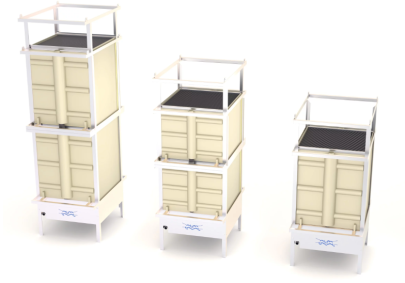
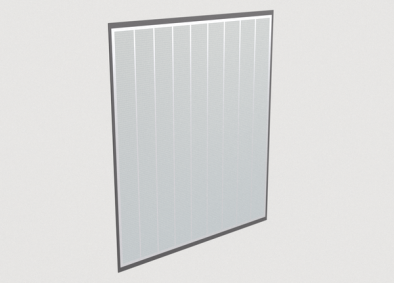
LowResist™ - reduced membrane fouling and lower energy consumption
Alfa Laval’s unique LowResist design gives our membrane module an extremely low pressure drop. It is thanks to the ultra-low transmembrane pressure (TMP) that Alfa Laval MBR membranes require much less cleaning and maintenance that other MBRs on the market. The low TMP means there is no pore fouling, just easily removed surface fouling.It is also the reason Alfa Laval MBR filters can run on gravity with just 1 m of water above the module, making it possible to maximize capacity in a tank without having to use pumps.
In our new model we have improved the LowResist technology to reduce the transmembrane pressure even further. The new membranes have open sides, allowing the water to flow freely into the permeate boxes. This leads to a more even pressure distribution over the membrane, which improves capacity and reduces cleaning needs.
S Aerator™
The new MBR model features the S Aerator aeration system developed by Schwander Polska in cooperation with Alfa Laval. This new, improved system minimizes air consumption and eliminates the work of cleaning out blockages.
Blockages are a hassle in traditional, multi-line aeration systems. Cleaning and restarting them is a cumbersome, time consuming process. Alfa Laval’s new S Aerator uses a single-line design, making it self-flushing. Any blockages are automatically flushed out when the air pressure builds up. Water that has entered the system due to the blockage is also flushed out automatically, meaning there is no need for manual intervention at any stage.
The self-flushing design makes it easy to turn the air on and off during operation and allows you to run your membrane modules with alternating aeration. This means that in systems with more than one membrane module, air scouring is applied in an alternating manner, not continuously. This is possible without fouling becoming a problem thanks to the extremely low TMP. The big benefit is reduction of energy consumption by 405 is savings in energy, investment and maintenance costs.
The end of the aeration line is a vertical pipe open at the bottom. This design lets you clearly see if you are over-aerating your bioreactor. Any bubbles from the end pipe indicate that the system is receiving too much air.


QuickSwap™ - easy membrane replacement
Membranes are easily installed and replaced thanks to Alfa Laval’s unique QuickSwap™ technology. Alfa Laval’s unique QuickSwap™ technology means each pack can be removed individually, minimizing the lifting height required above the membrane module. This means that Alfa Laval’s MBR membrane modules are especially suitable for indoor or subterranean installations where extra lifting height means more capital cost.
Membranes are easily replaced thanks to the QuickSwap™ technology. With all of the membranes in a module mounted in packs, an entire pack can be replaced in one operation, instead of having to replace each membrane element individually.
To replace a pack, just lower the tank level, take out the old pack and put in a new one. There is no need to take the entire module out of the tank or spend time ensuring each membrane element is in place after replacing the membranes.
Optimised for high capacity
The new Alfa Laval MBR membrane modules only require two free sides during operation and can therefore be installed side by side in rows, thereby increasing the installed membrane density dramatically.
The range of different module sizes in combination with the low water depth required for gravity operation makes it possible to optimize usage of existing tanks and maximize the installed membrane area. With Alfa Laval’s solution you get the most membrane area per tank volume.
The high resistance to fouling and absence of pore fouling in an Alfa Laval MBR membrane makes it possible to operate the bioreactor with up to 50% higher concentrations of suspended solids than other manufacturers’ filters.
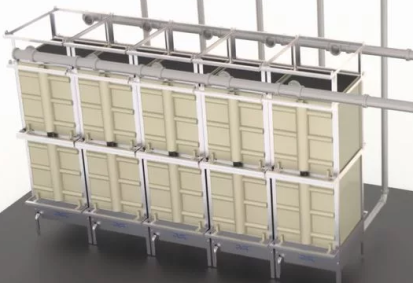
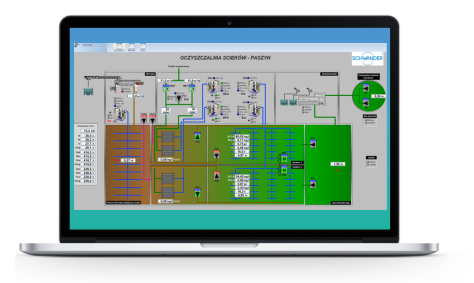
Fully automated for low personnel requirements
Personel cost is one of the highest expenses among operating costs of the operator of the plant. Schwander Polska's wastewater treatment plants are fully automated, which is why all essential parameters of the wastewater treatment process may be launched, contolled and monitored with remote supervision using any web-enabled device. It allows for the significant reduction of the personnel costs, which translates into direct savings of the operator of the plant. The system enables remote control, visualisation of technological process, alarm management, reminding about maintenance works to be done, control of alarms and metering devices as well as archiwing and processing of long-term data. The system operates based on the control algorithms determining the optimal values of process parameters, such as: aeration intensity, internal recirculation or discharge of excess sludge.
The automation and control systems at Schwander Polska's wastewater treatment plants guarantee the stability of the process and proper operation of the plant, as well as obtaining the required quality of treated wastewater. What is more, due to them, the operator of the plant may be sure, that the required parameters will be achieved with minimal consumption of energy and chemicals.
Outstanding water quality
One of the greatest advanteges of the membrane bioreacots is the exquisite quality of treated effluent, which is independent from the sediment properties of the activated sludge.The effect of preliminary disinfection of treated wastewater - The membrane is an absolute, physical barrier that removes all bacteria and a number of other pathogens, as well as all microplastics, making it suitable for a number of beneficial re-use applications, for example irrigation. At our wastewater treatment plants, the filtrate is returned to the system and used as process water, which translates into direct savings for the operator of the plant.
An MBR system is also a great solution for removing compounds of emerging concern, micropollutants and pharmaceuticals from municipal and hospital wastewater.
Alfa Laval MBR membranes are California Title 22-accredited and have been proven totally effective in removing microplastic pollutants in recent studies of a wastewater treatment plant in Denmark. Therefore, you can be sure to meet your future operational needs and those of your local environment.


Minimal cleaning
The ultra-low trans-membrane pressure (TMP) that is the foundation of the LowResist membrane module technology minimizes fouling and in turn cleaning needs. The low TMP eliminates pore fouling which means the only cleaning an Alfa Laval MBR filter ever needs is relaxation/air scouring every 10 minutes and CIP 3-4 times per year.
In other words:
- No backflushing
- Low requirements for chemical backwash and no soakings in most cases
- No need to ever remove the filter module from the tank during its lifetime
- Minimal CIP
- Minimal use of chemicals
- Huge time savings
- Less wear and tear on membranes and pumps
Low energy costs
Energy is the main cost of operating an MBR plant, making energy efficiency a primary concern. Schwander Polska MBR wastewater treatment plants offer market-leading performance at the lowest possible energy cost, due to the benefits from gravitational flow and simplicity of the system.
The unique design of our MBR membranes makes it possible to operate them using gravity as the only driving force, eliminating costs for pumping power. New S Aerator™, developed by Schwander Polska in cooperation with Alfa Laval, lets you optimize air scouring, and in turn the energy consumption for the air blower, without risking increased blockages in the aerator or increased membrane fouling.

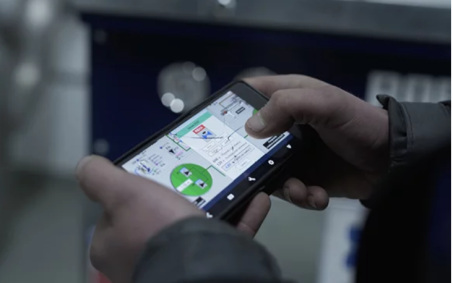
Easy, reliable operation
Every detail of an Schwander Polska MBR filtration system has been designed and manufactured specifically for use in wastewater applications. There are no moving parts or valves in the sludge, and pump usage has been minimized. Nothing has been left to chance to secure maximum reliability and the lowest possible maintenance requirements.
In case you need to replace a membrane, our unique QuickSwap system lets you do this in record time in the membrane tank. No advanced training for your personnel is required if you are revamping an existing wastewater treatment plant to MBR technology. All the technologies in our system will be familiar to your staff.
CAPEX - low investment cost
Schwander Polska offers maximum capacity in any available space. Regardless if you are building a new plant or upgrading an existing one, you will see that our solutions reduce capital expenditure (CAPEX).
New plants
For new plants, you can save greatly on civil works by choosing Schwander Polska technology. High concentration of biomass in the reactor allows for shorter time of wastewater retention in the bioreactor, which means that the size of the bioreactor can be even up to 3 times smaller than for the conventional technologies. The size of the membrane tank can be also smaller than for other MBR systems thanks to the high membrane density and ability to operate with a higher concentration of suspended solids. You will also save on pumps and piping thanks to the simplicity of the design of the system, since it can operate with gravity as the driving force.
Existing plants
For existing plants, the great flexibility of our MBR filtration system makes it possible to tailor it to any existing infrastructure. You can choose if you wish to let gravity drive the system or use low-energy permeate pumps. With our range of membrane modules in different sizes, we can pack maximum membrane capacity into your existing tank(s).


Seasonality – perfect solution for tourism
Schwander Polska technology, due to the outstanding water quality is recommended especially for the touristically attractive regions, for modernisation of the existing wastewater facilities and for the discharge of treated wastewater to recipients which require special protection, such as: small waterways, lakes or bathing water.
Schwander Polska MBR wastewater treatment plant main characteristics is their flexibility, which is why they will fit perfectly for applications with seasonal load variations, making it a reliable solution both during and after peak tourist season. The increase in the capacity of the plant and receiving peak hydraulic and organic loads is done without the necessity of expensive plant retrofit, usually it only requires to adjust the settings of the plant software.
No unpleasant odours
All wastewater treatment plants designed and built by our company are equipped with odour control systems which are responsible for the neutralisation of odours unpleasant for the employees and environment. This restricts the impact of wastewater treatment plant to the area of a land plot.
Deodorisation is performed with a biofilter filled with biologically active filtration material or a carbon filter with chemical sorbents filling or properly impregnated active carbon. This allows for the wastewater treatment plant to be located in the vicinity of other buildings.
Some examples of such plants: Piątkowa WWTP - adjacent to the children playground and school or Chełmiec WWTP - located in a town centre, near the municipality administration buildings.
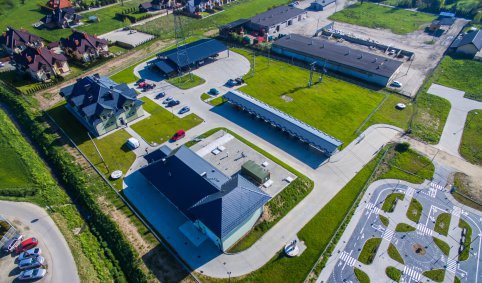

Minimal MBR maintenance
The ultra-low transmembrane pressure and absence of pore fouling means very little cleaning is needed. During normal operation it is enough with a 2 minute relaxation period every 10 minutes for the scouring air to remove the surface fouling.
There is no need for frequent backflushing or chemically enhanced backwashing – only a CIP cleaning every three or four months. The time savings compared to other MBR systems are very large.
The long CIP cleaning cycles also brings the benefits of minimizing wear on the membranes and chemical usage.
Equipment service
Our MBR systems are characterized by easy and infrequent service due to using gravity as a driving force, decreasing the number of pumps and simplifying the installation as well as cooperation only with market-leading equipment suppliers.The modular design means you only need 1.3 m clearance over the tank edge to lift the modules in place during installation. This is valuable if your MBR is indoors and space is limited.
We offer professional services of equipment service and maintenance of facilities and installations as well as continuous support for the operators of the plant in the process of equipment servicing. In order to learn more, please go to Maintenance.

Membrane module operating data
| Membrane type | MFP2 |
| Pore size | 0.2 μm |
| Typical operating trans-membrane pressure (TMP) | 0.01 ÷ 0.04 bar |
| Typical operating flux range | 10 ÷ 30 LMH |
| Maximum temperature | 50°C |
| pH range | 1 ÷ 11 |
1 Depending on the actual conditions and wastewater composition
Membrane module - materials of construction
| Module frame | stainless steel AISI 316 |
| Permeate piping and aerating systems | stainless steel AISI 316 |
| Membrane plate and separator | polypropylene (PP) |
| Membrane | polyvinylidene fluoride (PVDF) |
| Type of the aerating system | coarse-bubble aerator |
| Aeration system | acid-resistant stainless steel AISI 316 |
| Aeration connection | 1½ " BSP / NPT |
| Permeate connection | 2 " BSP / NPT |






